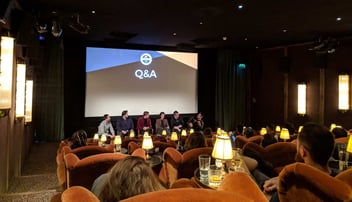When I was approached by Jo Rae of Kraken Films to shoot using a new remote system whereby I would remain off set, I was filled with both intrigue and trepidation. Directing is a very personable job and to be separated from your cast and crew could surely only diminish the effectiveness of delivering the vision, right? Wrong. In fact, I would go as far as saying that this new and initially strange approach to directing has unearthed some unexpected positives.
Firstly, though, let’s talk about the process from a tech point of view. The Viper system I used allowed me much more control over the shoot than I had anticipated. I had access to all Heads of Department, who were available through headsets; I had a clear view of the floor and I had the ability to be seen and heard by the whole crew via a monitor on set – effectively an open channel for wider discussion. I also had a feed to the shooting cameras, mobile video links to costume and makeup, an instant playback facility, and as this was all transmitted through Zoom, I had access to client and producers, plus the option of breakout rooms for more private conversations.
While all this access was great, the sense of separation as I sat directing from my home was, for the first few hours at least, somewhat strange – a weird sense of detachment as I watched the crew set up. My feeling is that this might not suit all directors, especially those who create energy on set through the projection of their personalities. There is no doubt that by being absent on set, your role becomes more traditional. You have to be comfortable in your own skin and trust your team. In my opinion, this will work best when you as a director are working with crew, especially a DoP, who you have a strong working relationship with, people who understand you and your style.
The key to all this is clear and focused communication. For me, on this occasion, the tech held up well, which is saying something considering we were effectively shooting in a concrete bunker! The ability to communicate to specific HoDs, clients and cast, both as a group and independently, is much more structured than being on set. There is less chance of being side tracked by conversation and distraction (especially given the limited number of crew who are actually on location, as per APA Covid guidelines). Instead, the approach does allow more focus on the moment at hand. Unexpectedly, something else I gained from this approach was a better bird’s-eye view of the action and the set itself. If you are a director who doesn’t use the monitor, this is going to be less effective for you, but in my case, it allowed me to look at each moment as we were capturing it in a slightly different way. I suppose it’s a bit like a football manager who is used to standing on the touchline conveying directions to his or her players, now moving to the stands to get a wider, different perspective.
Obviously, remote systems are nothing new in feature films. Those employing heavy VFX integration have used them for years. This brings me to another positive: whereas in the past, bringing specialist post-production crew, such as a VFX supervisor, editors or sound designers into an on-set discussion would mean them travelling to location, using a remote system invalidates this, offering a greater creative reach. During my experience, I was able to bring my editor onto the system, allowing her to watch the shoot and see the shots as we were filming them. I was able to communicate directly with her, live, and dissect the moments and takes I liked, discussing coverage as we were shooting. It was an invaluable resource that meant she was able to understand so much more by being present, simply by dialing in from the comfort of her suite.
So to wrap up, I cannot deny that this experience was unusual and new. It certainly will be challenging for some directors. It did feel slower at points and of course adding tech to any shoot comes with a risk of delay, but during the experience I had, it worked well. The key is to ensure good communication and ample pre production. If this is the new normal, it can be a positive one.




